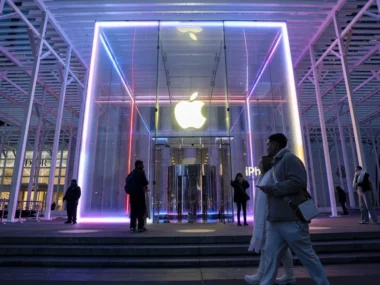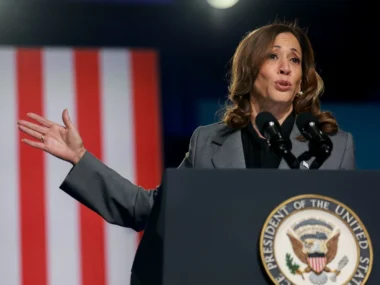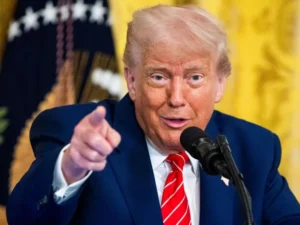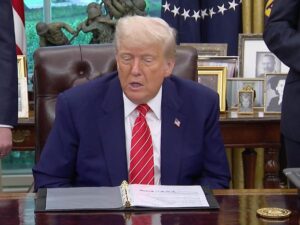President Donald Trump hinted at a major trade announcement set for Thursday, with a source telling CNN the deal will involve the United Kingdom.
This development suggests a potential easing of steep tariffs that have raised concerns about economic damage both in the U.S. and globally.
“Big News Conference tomorrow morning at 10:00 A.M., The Oval Office, concerning a MAJOR TRADE DEAL WITH REPRESENTATIVES OF A BIG, AND HIGHLY RESPECTED, COUNTRY. THE FIRST OF MANY!!!” Trump posted on Truth Social Wednesday night, without naming the country involved.
Although the post didn’t mention a specific nation, the Trump administration had ongoing talks with countries including India, the UK, South Korea, and Japan. Trump’s trade adviser Peter Navarro previously indicated the UK might be first to finalize a deal.
Navarro told CNN that while India and the UK were both in the mix, delays with India could mean the UK would sign first. He emphasized that the U.S. was on track to reach multiple trade agreements beneficial to Americans.
According to the Financial Times, a trade pact with the UK could be confirmed this week, potentially eliminating certain non-tariff barriers, such as the 2% digital services tax affecting U.S. tech firms. In return, the U.S. might reduce or lift 25% tariffs on British aluminum, steel, and autos. Despite ongoing negotiations with over a dozen countries, no deals had been finalized yet. Trump has often said he’s in no hurry to strike agreements, arguing that past trade practices have disadvantaged the U.S. and that current tariffs help restore balance.
Not Expected to be a Genuine Agreement.
Although the administration claims to be in advanced trade talks with over a dozen countries, formal trade agreements generally take years to finalize due to their complexity and the political challenges involved in protecting domestic interests.
Rather than a comprehensive deal, the agreement mentioned by Trump is more likely a memorandum of understanding. While this might temporarily reduce tariffs on a specific country’s products, it won’t translate into a meaningful economic benefit any time soon.
And this only covers one case. The reciprocal tariffs introduced on April 7—then paused for 90 days on April 9—impact many countries. On top of that, around 100 others face a flat 10% tariff. It’s highly improbable that all these trade negotiations could be concluded by the July 8 deadline.
Jacob Jensen, a trade policy expert at the American Action Forum, noted that the 90-day suspension—already about one-quarter through—doesn’t offer enough time for the detailed negotiations typically required to craft solid trade deals.
He also emphasized that there’s a key distinction between formal, written trade agreements and informal promises to purchase more U.S. goods—only the former offer lasting economic impact.
Trump has said he doesn’t plan to extend the tariff pause again and might even reintroduce some tariffs in the next few weeks if negotiations don’t succeed.
Jensen added that negotiating roughly 100 trade deals in just 90 days is nearly impossible, meaning the president will soon have to choose between resuming tariffs or extending the pause.
Even if agreements are reached, there’s no certainty Trump will honor them. For instance, although he led the creation of the USMCA deal with Canada and Mexico during his first term, he later imposed fluctuating tariffs on both countries’ goods and disrupted several other long-standing trade agreements.
Indications of Reduced Tensions
Trump’s announcement of a trade agreement marks the second major indication this week that the administration might be moving toward negotiations that could eventually ease some tariffs on foreign imports.
On Tuesday, Treasury Secretary Scott Bessent revealed plans for him and U.S. Trade Representative Jamieson Greer to travel to Geneva, Switzerland, for discussions with Chinese officials.
Although Bessent cautioned during a Fox News interview that a breakthrough deal shouldn’t be expected, he acknowledged the talks as a significant step toward easing tensions. Currently, the U.S. has imposed tariffs of at least 145% on most Chinese goods, while China has retaliated with 125% tariffs on American products.
However, Trump stated on Wednesday that he wouldn’t reduce tariffs on China ahead of any negotiations—something Beijing has long demanded as a condition for talks.
When asked in the Oval Office whether he’d consider lowering the steep tariffs to initiate talks with China, Trump responded with a firm “No.”
Still, any easing of the trade conflict would be a positive signal for businesses and consumers globally.
The high tariffs have already had damaging effects, particularly on the U.S. economy, which contracted in the first quarter for the first time in three years. Many companies had stockpiled inventory ahead of the “Liberation Day” tariffs, which kicked in during the second quarter.
While the standoff with China is the most intense, Trump has also levied broad tariffs on other countries: a 10% flat rate on nearly all imports into the U.S., plus 25% duties on steel, aluminum, autos, auto parts, and certain goods from Mexico and Canada.
This makes Thursday’s announcement and the upcoming U.S.-China discussions a focal point for global attention.
Federal Reserve Chair Jerome Powell noted in a Wednesday press briefing that tariffs could inflict serious harm on the U.S. economy. However, he added that ongoing trade talks may help avoid the worst outcomes.
Meanwhile, global institutions like the IMF, OECD, and World Bank have all warned that Trump’s trade policies could severely disrupt global economic growth and increase inflation. Several U.S. economists and major banks have also forecast a potential U.S. recession within the year.











